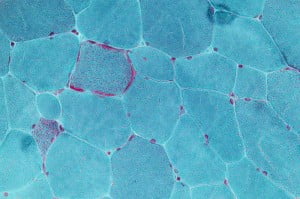What Is Mitochondria
mitochondria plural of mi·to·chon·dri·on
Noun: An organelle found in large numbers in most cells, in which the biochemical processes of respiration and energy production occur.Courtesy of Merriam-Webster Dictionary
There are a few characteristics which make mitochondria unique. The amount of mitochondria in a cell varies widely.
Contents |
History
Very first observations of intracellular structures that most likely represent mitochondria were published in the 1840s.
One popular term "powerhouse of the cell" was conceived by Philip Siekevitz in 1957.
Mitochondria are found in nearly all.
Function
A most easily seen role of mitochondria are to produce the energy currency of the cell, ATP , through respiration, and also to regulate cellular metabolism. However, the mitochondrion has many other performances in addition to the production of ATP.
Additional functions
Mitochondria play a prominent role in many other metabolic tasks, such as:
- Regulation of the membrane potential
- Apoptosis-programmed cell death
- Calcium signaling (including calcium-evoked apoptosis)
- Regulation of cellular metabolism
- Certain heme synthesis reactions (see also: porphyrin)
- Steroid synthesis.
As a matter of fact there are mitochondrial functions that are performed only in specific types of cells. For example, mitochondria in mitochondrial diseases.
Dysfunction and disease
Mitochondrial diseases
Most unhealthy people probably suffer from the damage and subsequent dysfunction in mitochondria which is an important factor in a range of human diseases due to their influence in cell metabolism. These mitochondrial disorders can at many times present themselves as neurological disorders, but can manifest as others.
Mitochondria disfuncitons play a significant role in cardiomyopathy in Type 2 diabetics. Increased fatty acid delivery to the heart increases fatty acid uptake by cardiomyocytes, resulting in increased fatty acid oxidation in these cells.
Possible relationships to aging
Mitochondria as considered as the cell's powerhouse, there may be some leakage of the high-energy.
During the aging process, many changes can occur to mitochondria. But, through experimentation it has been seen that aging non-mutant mice do not seem to accumulate a great number of mutations in mitochondrial DNA imposing a cloud of doubt on the involvement of mitochondrial DNA mutations in "natural" aging. Because of this, the exact relationships between mitochondria, oxidative stress, and aging have not yet been settled.
In popular culture
In Farandolae are fictional creatures that live inside mitochondria, and do circular "dances" around their "trees of origin".
In the 2012 feature film Jeremy Renner) contain a virus that implants itself in the user's cells, increasing mitochondrial output.
See also
See also
- Anti-mitochondrial antibodies
- Bioenergetics
- CoRR hypothesis
- Chloroplast
- Inhibitor protein
- Mitochondrial permeability transition pore
- Mitochondrial metabolic rates
- Nebenkern
- Oncocyte
- Oncocytoma
- Paternal mtDNA transmission
- Plastid
- Submitochondrial particle
- TIM/TOM complex
References
 This article incorporates "Science Primer".
This article incorporates "Science Primer".
This article uses material from the Wikipedia article Mitochondrion, which is released under the Creative Commons Attribution-Share-Alike License 3.0.

